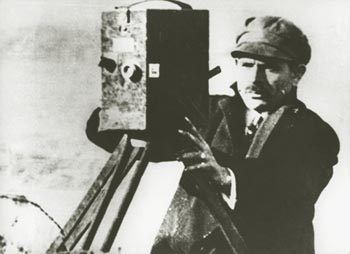 |
Milton Manaki
Janaki Manaki
|
 |

 |
Milton Manaki
Janaki Manaki
|
 |
 |
Manaki Brothers were born in a small Vlah village Avdela near the town Grevena (Kostur area). They started to work together in 1898. During this time Yanaki was a drawing professor in the high school in Yanina, where he opened his photo studio and had his younger brother Milton study photography. With his curious spirit and his diligence, Milton soon became a master of photography, learning everything from his brother Yanaki and was under his influencen 1904 Manaki brothers decided to live in Bitola so that was Milton's "last stop" becaouse in that period Bitola was an important political, economic and cultural center for the Balkans. In 1905 they moved their studio to Bitola and opened their well known "Studio for art photography". 1906 was also an important year for the Manaki brothers. At the invitation of King Karol the First they took part in the Big World Exhibition in Sinaia-Romania. They won a Gold medal for their photo collection and received the title of court photographers of His Majesty Karol the First. The older brother Yanaki was also paid to visit several europian capitals and thus started his international pilgrimage. Travelling to Paris Yanaki first stopped in Vienna then stayed briefly in London where he for the first time saw a film camera. That was the historical event for him. |
| The first "moving pictures" were made by the Manaki Brothers in their birthplace Avdela. There, they "immortalized" their 114 year old grandmother, Despina, together with other weavers in the village. The shot was extraordinary expressive and suggestive. And so began their great cinematographic opus, a testimony of their time, a rich and fruitful work. From the preserved materials we should mention the documentary film recordings of "The Visit of Sultan Mehmed V-th Rashid to Salonika and Bitola",_ "The Rumanian Minister Istrate visits Bitola, Gopesh and Resen", "The Nomad Karakachani", "The celebration of the relegious festival Epiphany", "The visit of Prince Alexander to Bitola", then series of shots of village and town weddings, national customs, rituals and celebrations, and the well known shots of the turkish reprisals against the Macedonian people after the Ilinden Uprising. |  |
 |
Besides the work in their photo-studio and shooting with photo
and film Camera 300-th, The Manaki Brothers were also showing films. The
first film in their new Cinema "Manaki" under open sky in "Wide Street"
was held in 1921. The "Cinema Garden" was a temporary solution which did
not satisfy the brothers. They later built a Cinema House and the first
projection there was on the first of December 1923. The Cinema worked with
variable success. It changed owners but in 1939 burnt to ashes...
In the film opus of Milton Manaki, his spontaneous recording, with a natural instinct for the most significant events in Bitola and its surroundings, was truly relevant. Analyzing the film materials, the first impression is that Milton Manaki, who shot most of these shots, had a factographic attitude towards reality. |